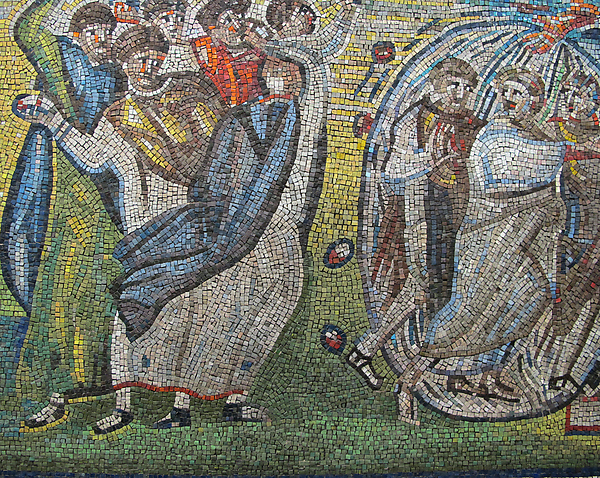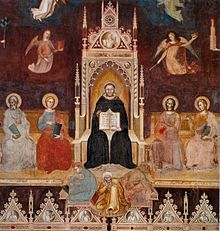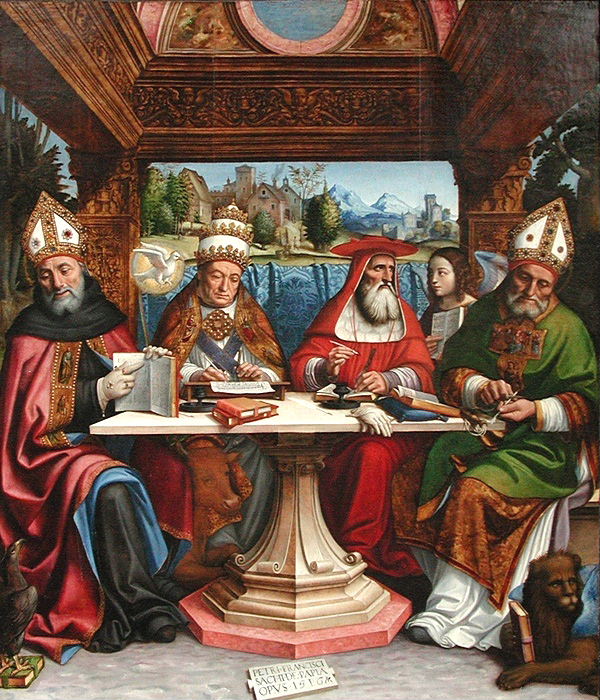
St. Thomas Aquinas, being “girded by angels with a mystical belt of purity…”
* * * *
January 28 is the feast day of perhaps the greatest intellect of the Catholic Church, St. Thomas Aquinas, known as the Angelic Doctor due to his purity of mind and body. He gave up a life of nobility and wealth to be a poor Dominican friar, at the time a new religious order, much to the consternation of his family.
See January 28 … Thomas Aquinas. See also Thomas Aquinas – Wikipedia, which noted that this St. Thomas is considered the Catholic Church’s greatest theologian and philosopher, and was “honored as a Doctor of the Church.”
 But first note the word “doctor” used here comes from the Latin docere. That means “to instruct, teach, or point out.”
But first note the word “doctor” used here comes from the Latin docere. That means “to instruct, teach, or point out.”
Thus Doctor of the Church – like St. Isidore of Seville, at left – “is a title given by a variety of Christian Churches, to those they recognize as “having been of particular importance, particularly regarding their contribution to theology or doctrine.”
(And incidentally, I’d argue that any good “doctor of the church” would recognize that he – or she – can learn as much from the person being taught, as he – or she – knows already. See also Seneca the Younger …)
So anyway, for more on what made this St. Thomas so special, see St. Thomas Aquinas. (From the Satucket website.) For starters, he was born in 1225 and died – a mere 49 years old – in 1274.
That means he lived right at the end of the Dark Ages. (A time of “cultural and economic deterioration” in Western Europe, “following the decline of the Roman Empire.”)
During the Dark Ages, one of the institutions that kept things together was “Holy Mother Church.” (In Latin, “Sancta Mater Ecclesia.”) But one problem was that – largely due to widespread illiteracy – the Bible became the only book that was widely studied. (And then only as interpreted by local parish priests, and many of them couldn’t read.)
 Thomas Aquinas changed things up. He “modernized” things.
Thomas Aquinas changed things up. He “modernized” things.
Ironically, he did that by reading golden oldies, books written by people like Aristotle. (Shown at “right right,” but who was at the time of Aquinas ” largely forgotten in Western Europe.”)
There was no such thing as printing – not until Gutenberg, in and around 1450 – and there were precious few books other than the Bible to “read.” (Or more likely, have read to you.)
But then by Aquinas’s time – after a “dark” millennium or more – such books started reappearing. (They’d been preserved “partly from Eastern European sources and partly from Moslem Arab sources in Africa and Spain.”) And like all good golden oldies, such re-discovered books got “liked:”
These works offered a new and exciting way of looking at the world. Many enthusiastic students of Aristotle adopted him quite frankly as as an alternative to Christianity. The response of many Christians was to denounce Aristotle as an enemy of the Christian Faith.
 Put another way, there were two initial reactions. Some people rejected the Bible and adopted the philosophy of Aristotle “whole cloth.” Others reacted vehemently and felt that reading such books bordered on heresy. (See On Moses getting stoned, on a similar phenomenon, illustrated at left.)
Put another way, there were two initial reactions. Some people rejected the Bible and adopted the philosophy of Aristotle “whole cloth.” Others reacted vehemently and felt that reading such books bordered on heresy. (See On Moses getting stoned, on a similar phenomenon, illustrated at left.)
Gradually a third approach emerged: Those “who tried to hold both Christian and Aristotelian views side by side with no attempt to reconcile the two.” And finally came Aquinas, who developed what has been called his “fourth approach:”
Aquinas had a fourth approach. While remaining a Christian, he immersed himself in the ideas of Aristotle, and then undertook to explain Christian ideas and beliefs in language that would make sense to disciples of Aristotle. At the time, this seemed like a very dangerous and radical idea, and Aquinas spent much of his life living on the edge of ecclesiastical approval. His success can be measured by the prevalence today of the notion that of course all Christian scholars in the Middle Ages were followers of Aristotle.
Another source said Aquinas “lived at a critical juncture of western culture when the arrival of the Aristotelian corpus in Latin translation reopened the question of the relation between faith and reason.” Which is another way of asking: “Can you be ‘smart’ and still believe in the Bible?“
(See also On broadminded, spelled “s-i-n”,” about the old – 1952 – Louvin Brothers song.)
Which is another way of saying that – even to this day – some believe you can’t do both. That you can’t have “true faith” and at the same time use your powers of reason. In other words, such people reject any modus vivendi. They say you have to choose between faith and reason.
And pardon me for saying so, but such people are idiots.** (Or at least greatly misled.)
 Which is another way of saying such views are antithetical to this blog. But I’m not alone. St. Thomas Aquinas – for one – is “on the same page” as me. (And the image at right is titled, “Triumph of St. Thomas Aquinas.”)
Which is another way of saying such views are antithetical to this blog. But I’m not alone. St. Thomas Aquinas – for one – is “on the same page” as me. (And the image at right is titled, “Triumph of St. Thomas Aquinas.”)
That is, beginning with Thomas Aquinas, people started reading books in addition to the Bible. And from that developed – in due course – things like the Wesleyan Quadrilateral. (Referring to the use of Scripture, Tradition, and Reason as a “methodology for theological reflection.”)
All of which brings us – as if “preordained before the beginning of time” – to one of the Daily Office Readings for Monday, January 25, 2016. (To wit: the Feast Day for the Conversion of St. Paul.) That reading is Ecclesiasticus – not to be confused with Ecclesiastes – 39:1-10;
He seeks out the wisdom of all the ancients… [H]e preserves the sayings of the famous and penetrates the subtleties of parables; he seeks out the hidden meanings of proverbs and is at home with the obscurities of parables.
Which is another of saying that when it comes to God – or for that matter the Bible:
There’s no such thing as a know-it-all…
* * * *

“Four Great Doctors,” including Saint Augustine and Saint Jerome…
* * * *
The upper image is courtesy of Thomas Aquinas – Wikipedia. The caption: “Diego Velázquez, Aquinas is girded by angels with a mystical belt of purity after his proof of chastity.”
Re: “Doctors” – as teachers – learning from their students:
One of the best ways to understand something is to try to explain it to others. If you want to test your own understanding of this new way of thinking, try springing it on some of your friends. Undoubtedly, you will discover something all teachers know – that the person giving instruction often learns more than the person receiving it…
See How to Develop Your Thinking Ability, by Kenneth S. Keyes, Jr., originally published in 1950. The quote is found on page 34 of the McGraw-Hill paperback edition, published in 1963.
See also Know-it-all – Wikipedia, referring to a person “who obnoxiously purports an expansive comprehension of a topic and/or situation when in reality, his/her comprehension is inaccurate or limited.” Based in part on Mr. Keyes’ point of view – with which I agree – I’d argue that – when it comes to “God” – there’s no such thing as a “know it all.” (Notwithstanding the massive evidence to the contrary in too many religious circles.)
And finally, see Learning by teaching – Wikipedia: “Seneca the Younger told … Lucilius that we are learning if we teach[:] docendo discimus (lat.: ‘by teaching we are learning’).”
* * * *
Here’s the full quote from the St. Thomas Aquinas link at Satucket, on his “fourth approach,” etc:
In the thirteenth century, when Thomas Aquinas lived, the works of Aristotle, largely forgotten in Western Europe, began to be available again, partly from Eastern European sources and partly from Moslem Arab sources in Africa and Spain. These works offered a new and exciting way of looking at the world. Many enthusiastic students of Aristotle adopted him quite frankly as as an alternative to Christianity. The response of many Christians was to denounce Aristotle as an enemy of the Christian Faith. A third approach was that of those who tried to hold both Christian and Aristotelian views side by side with no attempt to reconcile the two. Aquinas had a fourth approach. While remaining a Christian…
I added the emphasized “dangerous and radical idea,” in the quoted section in the main text. The all in “all Christian scholars in the Middle Ages” was emphasized in the original.
The image of Aristotle is courtesy of the Wikipedia article on Aristotle. A partial caption reads: “Plato (left) and Aristotle (right), a detail of The School of Athens, a fresco by Raphael.”
Re: Thomas living “at a critical juncture of western culture.” See Saint Thomas Aquinas (Stanford Encyclopedia of Philosophy). That article also used the term modus vivendi in a way that seemed incongruous at best, at least to me.
** Re: “such people are idiots.” That statement is an example of hyperbole, “the use of exaggeration as a rhetorical device or figure of speech.” Obviously – as a good Christian – I could never really believe such a thing. I merely believe that such Biblical literalists are greatly misquided. On the other hand, it seems that most people won’t listen to anything but overblown hyperbole these days…
Re: Antithetical. See also Anathema, referring to “something dedicated to evil and thus accursed.”
The side panel of Aquinas is courtesy of Thomas Aquinas – Wikipedia. The full caption: “Triumph of St Thomas Aquinas, ‘Doctor Angelicus,’ with saints and angels, Andrea di Bonaiuto, 1366. Basilica of Santa Maria Novella, fresco.”
Re: “Preordained before the beginning of time.” See also Ephesians 1:4, “For he [God] chose us in him before the creation of the world to be holy and blameless in his sight…”
On that note, the link phrased as “preordained before the beginning of time” – near the end of the main text – will take you to the article, Incentives, Predestination and Free Will, by “Glaeser, Edward L.,” and “Glendon, Spencer.” That excerpt distinguished some points of theology between Catholicism on the one hand and some brands of Protestantism:
One of the largest theological gaps between the denominations is that Calvinism accepts the dogma of predestination while Catholicism argues for a dogma of free will… Under predestination, a spiritual elite is preordained before the beginning of time and will receive eternal life. Under free will, it is only through a lifetime of good actions that individuals are accepted into Heaven. (E.A.)
Re: The difference between Ecclesiasticus and Ecclesiastes. The former – also known as Wisdom of Sirach – is “accepted as part of the Christian biblical canons by Catholics, Eastern Orthodox, and most of Oriental Orthodox. The Anglican Church [does] not accept Sirach as protocanonical, and say[s] it should be read only ‘for example of life and instruction of manners; but yet doth not apply them to establish any doctrine.'” Ecclesiastes on the other hand is far more widely known. It’s “one of 24 books of the Tanakh or Hebrew Bible” – classified as Ketuvim (or ‘Writings’) – and is “among the canonical Wisdom Books in the Old Testament of most denominations of Christianity.”
See also On Ecclesiasticus – NOT “Ecclesiastes,” which noted in part that the latter was popularized by the 1965 hit song “Turn! Turn! Turn!” See also The Byrds … YouTube.
The lower image is courtesy of the Doctor of the Church, at Thomas Aquinas – Wikipedia. The full caption: “The Four Great Doctors of the Western Church were often depicted in art, here by Pier Francesco Sacchi, c. 1516. From the left: Saint Augustine,Pope Gregory I, Saint Jerome, and Saint Ambrose, with their attributes.”